John Scotus, called Erigena ("Erin-born"), is quite another person (_-886). Erigena is sometimes called “Scotus the Wise,” and lived four centuries before “The Subtle Doctor.”
DUN-SHUNNER (Augustus), a nom de plnme of Professor William Edmonstoune Aytoun, in Blackwood’s Magazine (1813-1865).
DUNS’TAN (St.), patron saint of goldsmiths and jewellers. He was a smith, and worked up all sorts of metals in his cell near Glastonbury Church. It was in this cell that, according to legend, Satan had a gossip with the saint, and Dunstan caught his sable majesty by the nose with a pair of red-hot forceps.
DUNTHAL’MO, lord of Teutha (the Tweed). He went “in his pride against Rathmor,” chief of Clutha (the Clyde), but being overcome, “his rage arose,” and he went “by night with his warriors” and slew Rathmor in his banquet hall. Touched with pity for his two young sons (Calthon and Colmar), he took them to his own house and brought them up. “They bent the bow in his presence, and went forth to his wars.” But observing that their countenances fell, Dunthalmo began to be suspicious of the young men, and shut them up in two separate caves on the banks of the Tweed, where neither “the sun penetrated by day nor the moon by night.” Colmal (the daughter of Dunthalmo), disguised as a young warrior, loosed Calthon from his bonds, and fled with him to the court of Fingal, to crave aid for the liberation of Colmar. Fingal sent his son Ossian with 300 men to effect this object, but Dunthalmo, hearing of their approach, gathered together his strength and slew Colmar. He also seized Calthon, mourning for his brother, and bound him to an oak. At daybreak Ossian moved to the fight, slew Dunthalmo, and having released Calthon, “gave him to the white-bosomed Colmal.”—Ossian, Calthon and Colmal.
DUPELEY (Sir Charles), a man who prided himself on his discernment of character, and defied any woman to entangle him in matrimony; but he mistook Lady Bab Lardoon, a votary of fashion, for an unsophisticated country maiden, and proposed marriage to her.
“I should like to see the woman,” he says, “that could entangle me ... Shew me a woman ...and at the first glance I will discover the whole extent of her artifice.”—Burgoyne, The Maid of the Oaks, i. I.
DUPRE [Du.Pray’], a servant of Mr. Darlemont, who assists his master in abandoning Julio, count of Harancour (his ward) in the streets of Paris, for the sake of becoming possessor of his ward’s property. Dupre repents and confesses the crime.—Th. Holcroft, The Deaf and Dumb (1785).
DURAN’DAL, the sword of Orlando, the workmanship of fairies. So admirable was its temper that it would “cleave the Pyrenees at a blow.”—Ariosto, Orlando Furioso (1516)
DURANDAR’TE (4 syl.), a knight who fell at Roncesvalles (4 syl.). Durandarte loved Belerma whom he served for seven years, and was then slain; but in dying he requested his cousin Montesi’nos to take his heart to Belerma.




